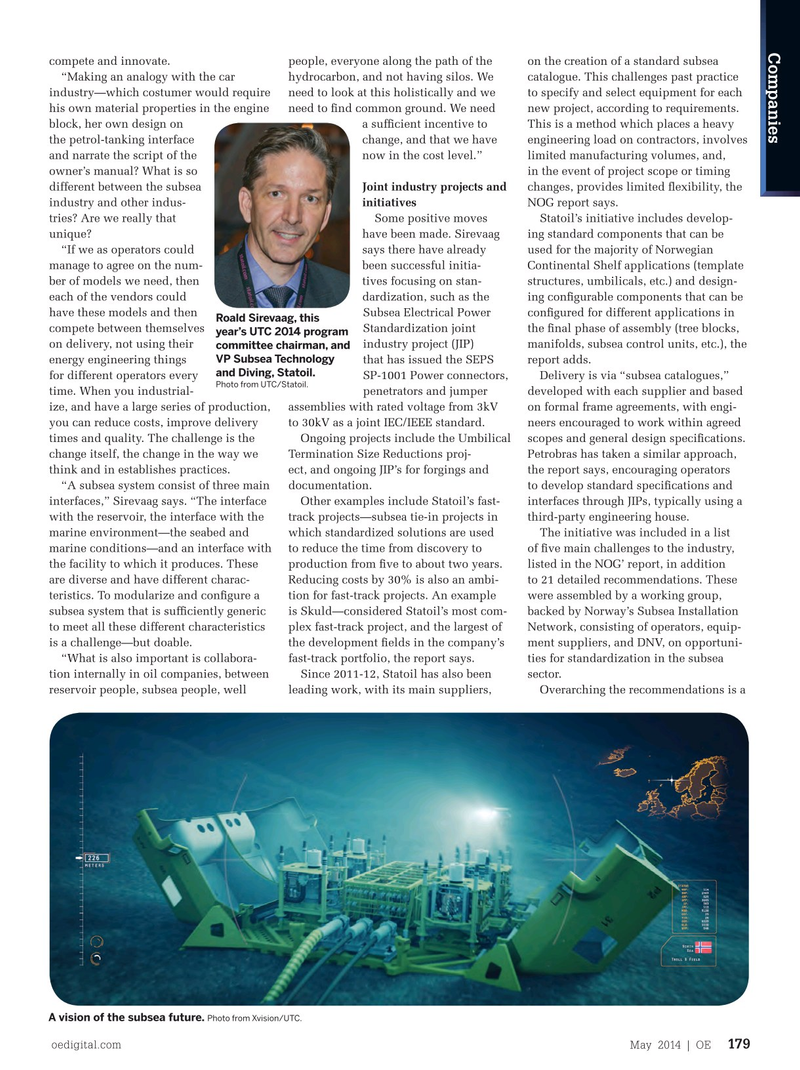
Page 177: of Offshore Engineer Magazine (May/Jun 2014)
Read this page in Pdf, Flash or Html5 edition of May/Jun 2014 Offshore Engineer Magazine
Companies compete and innovate. people, everyone along the path of the on the creation of a standard subsea “Making an analogy with the car hydrocarbon, and not having silos. We catalogue. This challenges past practice industry—which costumer would require need to look at this holistically and we to specify and select equipment for each his own material properties in the engine need to fnd common ground. We need new project, according to requirements. block, her own design on a suffcient incentive to This is a method which places a heavy the petrol-tanking interface change, and that we have engineering load on contractors, involves and narrate the script of the now in the cost level.” limited manufacturing volumes, and, owner’s manual? What is so in the event of project scope or timing different between the subsea Joint industry projects and changes, provides limited fexibility, the industry and other indus- initiatives NOG report says.
tries? Are we really that Some positive moves Statoil’s initiative includes develop- standards is also time consuming and unique? have been made. Sirevaag ing standard components that can be frequently lags behind the deployment “If we as operators could says there have already used for the majority of Norwegian of new technologies or the inclusion of manage to agree on the num- been successful initia- Continental Shelf applications (template lessons learned. ber of models we need, then tives focusing on stan- structures, umbilicals, etc.) and design- “Much of the future Norwegian each of the vendors could dardization, such as the ing confgurable components that can be
Continental Shelf (NCS) oil and gas will have these models and then Subsea Electrical Power confgured for different applications in
Roald Sirevaag, this come from marginal projects and tie- compete between themselves Standardization joint the fnal phase of assembly (tree blocks, year’s UTC 2014 program backs, where cost and delivery times are on delivery, not using their industry project (JIP) manifolds, subsea control units, etc.), the committee chairman, and
VP Subsea Technology critical divers,” according to the report. energy engineering things that has issued the SEPS report adds. and Diving, Statoil. “It is clear… that ‘business as usual’ is no for different operators every SP-1001 Power connectors, Delivery is via “subsea catalogues,”
Photo from UTC/Statoil. longer an option.” time. When you industrial- penetrators and jumper developed with each supplier and based ize, and have a large series of production, assemblies with rated voltage from 3kV on formal frame agreements, with engi- ‘Business as usual’ you can reduce costs, improve delivery to 30kV as a joint IEC/IEEE standard. neers encouraged to work within agreed is no longer an option times and quality. The challenge is the Ongoing projects include the Umbilical scopes and general design specifcations.
DNV GL’s report, Subsea Facilities – change itself, the change in the way we Termination Size Reductions proj- Petrobras has taken a similar approach,
Technology Developments, Incidents think and in establishes practices. ect, and ongoing JIP’s for forgings and the report says, encouraging operators and Future trends, says “standardized “A subsea system consist of three main documentation. to develop standard specifcations and building block design feld develop- interfaces,” Sirevaag says. “The interface Other examples include Statoil’s fast- interfaces through JIPs, typically using a ments” will be one of the two key themes with the reservoir, the interface with the track projects—subsea tie-in projects in third-party engineering house. for the subsea industry going forward, the marine environment—the seabed and which standardized solutions are used The initiative was included in a list other being “the advanced subsea system, marine conditions—and an interface with to reduce the time from discovery to of fve main challenges to the industry, where new and novel technology will be the facility to which it produces. These production from fve to about two years. listed in the NOG’ report, in addition developed.” are diverse and have different charac- Reducing costs by 30% is also an ambi- to 21 detailed recommendations. These
But, the report stresses that standard- teristics. To modularize and confgure a tion for fast-track projects. An example were assembled by a working group, ization applies not just to materials, subsea system that is suffciently generic is Skuld—considered Statoil’s most com- backed by Norway’s Subsea Installation specifcations or interfaces, but also how to meet all these different characteristics plex fast-track project, and the largest of Network, consisting of operators, equip- projects are delivered or handed over to is a challenge—but doable. the development felds in the company’s ment suppliers, and DNV, on opportuni- the client. “What is also important is collabora- fast-track portfolio, the report says. ties for standardization in the subsea “The overall aim with standardization tion internally in oil companies, between Since 2011-12, Statoil has also been sector. is to remove work that does not contrib- reservoir people, subsea people, well leading work, with its main suppliers, Overarching the recommendations is a ute to either quality or functionality,” it says. “One example today is the lack of a common standard for supply of materi- als. The effect of this is that the supply chain is hesitant to order materials [at their] own risk and cost prior to hav- ing a contract with a customer in place.
Typically, this adds 7-12 months of lead time for forgings.”
Roald Sirevaag, the UTC 2014 program committee chairman, and VP Subsea
Technology and Diving, Statoil, says: “I defnitely need to do something. But you need an overriding vision of what you want to achieve, and that vision has been non-existent.”
Sirevaag’s vision, which he aims to share at UTC, is an analogy with car manufacturing, in which manufacturers have different models for different seg-
A vision of the subsea future. Photo from Xvision/UTC. ments of the market, but still manage to oedigital.com May 2014 | OE 179 000_OE0514_Activity.indd 179 4/19/14 2:10 PM

 176
176

 178
178